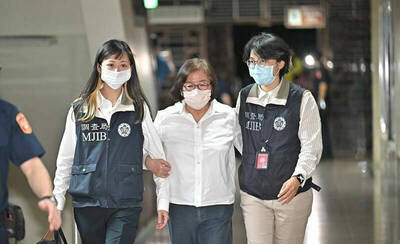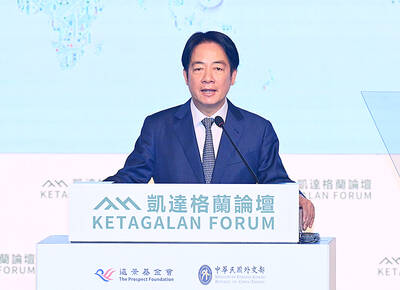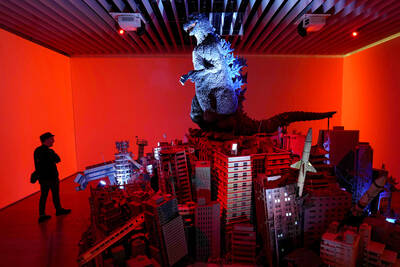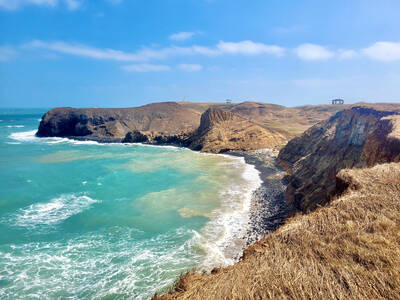Yogurt Art turns customers into creators — at least for the two minutes it takes to create a dessert.
The recently opened self-service joint in Gongguan (公館), located across the street from National Taiwan University’s main gate, serves frozen yogurt and a multitude of toppings.
Becoming an aesthete is as easy as walking through the door, choosing a cup — 390ml, 520ml or 750ml — and then filling it with any combination of the eight yogurt varieties dispensed from four machines.
Then it’s off to the display counter to add any (or all) of the 24 toppings, weigh the objet d’art and pay. A warning to those who don’t want to create a monumental canvas: the 390ml size is more than enough for a masterpiece that will satiate one person’s appetite.
The palette of yogurt flavors includes berry tart, white chocolate macadamia nut, country vanilla, cable car chocolate, New York cheesecake, cappuccino, green tea tart and plain tart. Yogurt Art changes the flavors once a month. There are 30 in total.
On my first visit, I paired berry tart with New York cheesecake — a little country living combined with downtown flair. Then, it was on to the toppings counter where I added strawberries, kiwi, peach and blueberries. Weighing in at just over 200g, it cost NT$123.
The only disappointment was the peach, which was canned.
If my first creation tended toward “environmental art,” a second attempt a few days later was pure decadence.
The underpainting was a grisaille of cappuccino, cable car chocolate and white chocolate macadamia nut. As the base looked somewhat bland, I added Gummi bears, marshmallows, M&Ms and pieces of Oreo cookie. The cost: NT$107.
Rich chocolate and macadamia nut — what can go wrong?
The cappuccino was lost among the stronger flavors, none of which were too sweet. I deserved a critical review for the overpainting of toppings, though. The Gummi bears and marshmallows were difficult to chew because the frozen yogurt had hardened them into a texture resembling that of rubber. And the M&Ms were as hard as pebbles.
Next time I’ll stick to toppings possessing a similar texture to that of the Oreos pieces, such as Froot Loops, granola or Cheerios, which are smaller in size and easier to eat. Other add-ons include whole and sliced almonds, walnut pieces, dried cranberries and raisins.
Yogurt Art’s interior is geared towards the up-market health-conscious crowd. High ceilings painted vanilla are framed by large picture windows that provide gentle natural lighting and views of the passing crowds. The friendly and helpful counter staff is kept busy cleaning the store’s eight tables, yogurt dispensing machines and the area around the toppings counter.
Yogurt Art also has a location at 14, Alley 8, Ln 216, Zhongxiao E Rd, Sec 4, Taipei City (台北市忠孝東路四段216巷8弄14號). Tel: (02) 8771-5366.

Following the shock complete failure of all the recall votes against Chinese Nationalist Party (KMT) lawmakers on July 26, pan-blue supporters and the Chinese Communist Party (CCP) were giddy with victory. A notable exception was KMT Chairman Eric Chu (朱立倫), who knew better. At a press conference on July 29, he bowed deeply in gratitude to the voters and said the recalls were “not about which party won or lost, but were a great victory for the Taiwanese voters.” The entire recall process was a disaster for both the KMT and the Democratic Progressive Party (DPP). The only bright spot for

As last month dawned, the Democratic Progressive Party (DPP) was in a good position. The recall campaigns had strong momentum, polling showed many Chinese Nationalist Party (KMT) lawmakers at risk of recall and even the KMT was bracing for losing seats while facing a tsunami of voter fraud investigations. Polling pointed to some of the recalls being a lock for victory. Though in most districts the majority was against recalling their lawmaker, among voters “definitely” planning to vote, there were double-digit margins in favor of recall in at least five districts, with three districts near or above 20 percent in

From Godzilla’s fiery atomic breath to post-apocalyptic anime and harrowing depictions of radiation sickness, the influence of the nuclear bombings of Hiroshima and Nagasaki runs deep in Japanese popular culture. In the 80 years since the World War II attacks, stories of destruction and mutation have been fused with fears around natural disasters and, more recently, the Fukushima crisis. Classic manga and anime series Astro Boy is called “Mighty Atom” in Japanese, while city-leveling explosions loom large in other titles such as Akira, Neon Genesis Evangelion and Attack on Titan. “Living through tremendous pain” and overcoming trauma is a recurrent theme in Japan’s

The great number of islands that make up the Penghu archipelago make it a fascinating place to come back and explore again and again. On your next trip to Penghu, why not get off the beaten path and explore a lesser-traveled outlying island? Jibei Island (吉貝嶼) in Baisha Township (白沙鄉) is a popular destination for its long white sand beach and water activities. However, three other permanently inhabited islands in the township put a unique spin on the traditional Penghu charm, making them great destinations for the curious tourist: Yuanbeiyu (員貝嶼), Niaoyu (鳥嶼) and Dacangyu (大倉嶼). YUANBEIYU Citou Wharf (岐頭碼頭) connects the mainland